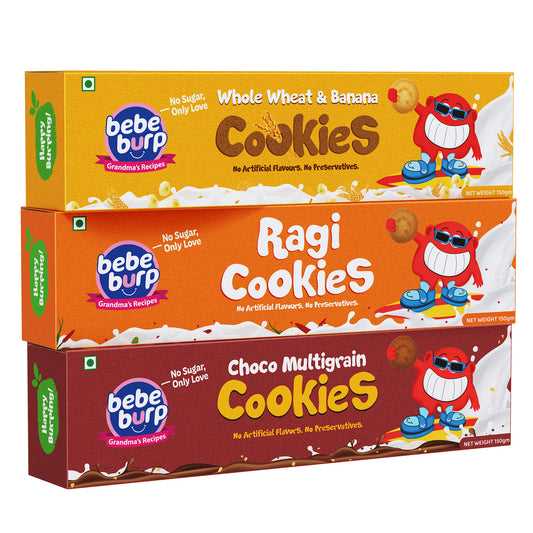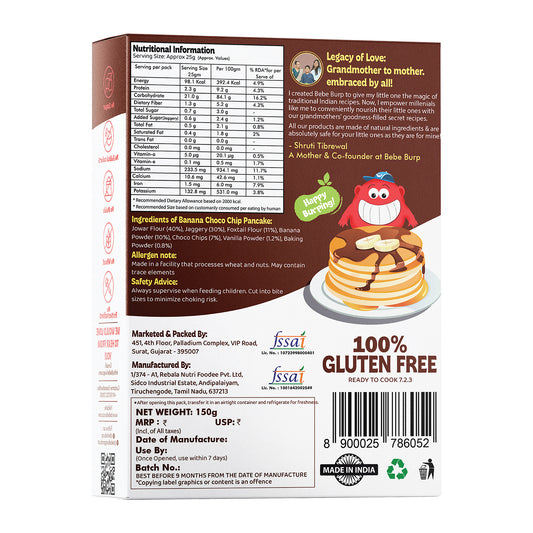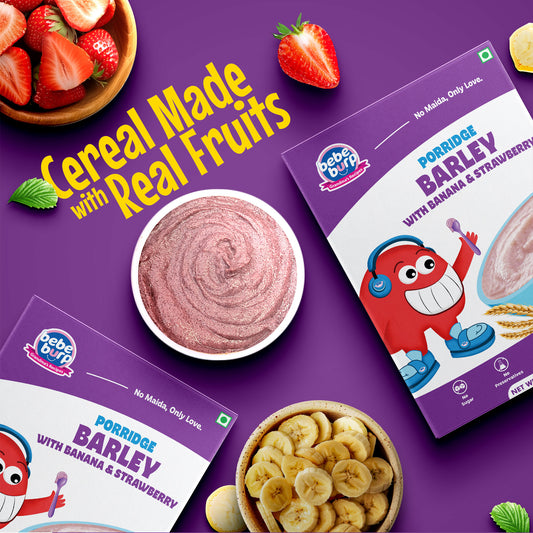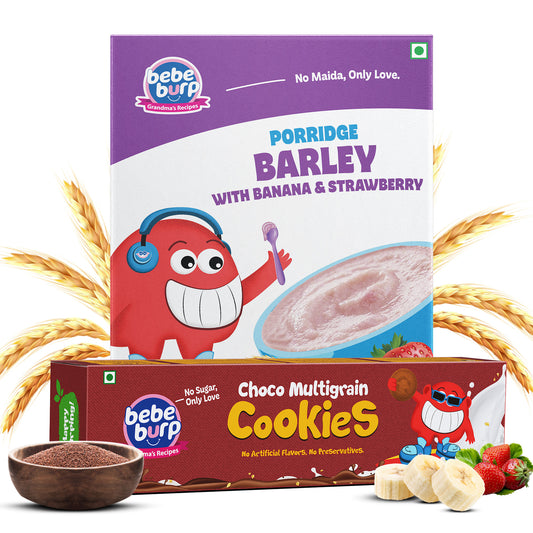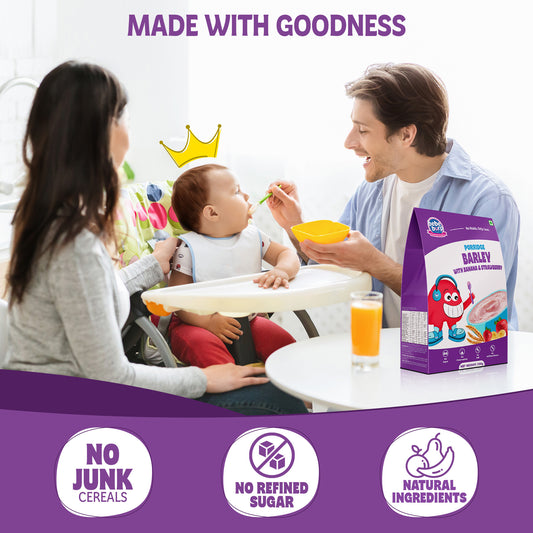Confused about whether to start your baby on ragi vs wheat first? The answer depends on your baby’s age and nutritional needs.
Ragi is perfect for babies under six months because it’s high in calcium and iron and easy to digest.
Wheat, on the other hand, is better for older babies (8 months and up) when they need more energy and protein to support their growing bodies.
Both grains are healthy, but they serve different purposes in your baby’s diet.
Ragi vs Wheat – What’s the Difference?
Indian homes commonly use Ragi (finger millet) and wheat as daily grains. These grains differ in texture and taste.
They also offer a range of nutrients and health advantages.
Ragi
- Ragi, also known as finger millet, is a grain that is slightly tough to cook but has a nutty flavor. It is gluten-free and produces coarse flour.
- Calcium, iron and fiber are highly nutrient rich, making it an all-rounded powerhouse of benefits.
- Whole grain Ragi is very common in South Indian flour, it can be prepared as porridges, dosas, idlis and even baked in some of the southern states as bake ragi.
- Easy digestibility of this grain, and being gluten free makes it a great option for gluten-free People who avoid gluten and one can even feed this to babies as wean food.
- Ragi is also believed to have inherent cooling properties that help in controlling body heat during high temperatures.
Wheat
- Wheat: Wheat is a flour, very soft with mild flavor neutral gluten content that provides elasticity and expands to the dough used for baking.
- It is everyday food in North Indian households and used as a base to make roti, parathas, naans and semolina dishes like suji halwa and upma.
- Wheat is loaded with carbohydrates to fuel you up and a decent amount of protein, fiber, gluten, vitamin B-complex.
- Now, there are two main types: whole wheat (atta) and refined flour (maida).
- Attas are healthier, made from the whole grain, while maida is stripped down for things like cakes or pastries.
- Both come from wheat, but they’re used differently depending on what you’re cooking.
|
Nutrient |
Ragi (per 100g) |
Wheat (per 100g) |
Why It Matters for Babies |
|
Calcium |
344 mg |
30 mg |
Calcium is vital for strong bones and teeth, especially during teething months. Ragi contains 10x more calcium than wheat. |
|
Iron |
3.9 mg |
3.5 mg |
Iron supports brain development and prevents anemia. Both are good sources, but Ragi has a slight edge. |
|
Protein |
7.3 g |
12.6 g |
Protein helps in muscle growth, tissue repair, and overall development. Wheat offers a higher amount |
|
Fiber |
11.5 g |
12.2 g |
Fiber improves digestion and prevents constipation — very important during the weaning stage |
|
Gluten |
❌ No |
✅ Yes |
Ragi is naturally gluten-free, which is gentler on a baby’s tummy. Wheat contains gluten, which may cause intolerance in some babies. |
|
Digestibility |
✅ High |
⚠️ Moderate |
Ragi is easier to digest, making it suitable as a first solid food. Wheat is heavier and should be introduced after 8 months. |
Parent-Friendly Advice:
-
Start with Ragi (6+ months): Easy to digest and high in calcium and iron. Ideal for early development stages.
-
Introduce Wheat (8+ months): Great for protein as your baby becomes more active.
- Mix it up: Rotate both grains weekly to give your baby complete nutrition and variety.
Nutrition – Which One Has More Benefits for Babies?
For the first six months, breast milk is considered the ideal source of nutrition for babies, providing all the necessary nutrients and boosting the immune system.
If breastfeeding isn't possible or desired, infant formula is a healthy alternative.
When comparing ragi and wheat for babies, especially in the context of nutrition, both grains offer unique benefits, but ragi tends to have an edge in certain areas, particularly for younger infants.

Ragi (Finger Millet)
Ragi – Nutritional Value:
- Rich in calcium, iron, and fiber: Full of calcium, iron, and fiber
- 10 times calcium as that of wheat: Contains ten times more calcium than wheat
-
Exceptional food for bone building: Great for strengthening bones
Benefits:
- Bone health: Strong bones
- Good source of calcium for bone building: Helps in making bones stronger
- Iron: Contains high amounts of iron, which is necessary for preventing iron deficiency, especially for babies who may not get enough iron from breast milk or formula
- Ragi Aid Digestion: Helps with digestion as babies start eating solids
- Improvement in Brain Development: Boosts brain growth with important nutrients
Wheat
Nutrition Facts: Wheat is rich in the B vitamins, protein and fiber for consistent energy, grows muscles.
Benefits:
- Energy Provide: Carbohydrates in the wheat is a good source of energy for active babies
- Muscle gain: the protein content aids in muscle development since babies' muscles strengthen as they are more active.
- B Vitamins: Required for many metabolism and the general health of the body.
Recommendations
Babies Less Than 6 Months: Ragi is rich in iron and it is a much loved grain since it helps in preventing anemia for babies.
Another reason why this cereal is a good first food, considering it is easy on the stomach and essential nutrients.
8 months and up: some babies start solids at 8, using wheat since it will be a little more filling than the softer one (older babies can handle a fair amount of complex carbohydrates).
It could serve the purpose for variety as well as some extra nutrients in a general health diet.
Which One Should to Give First – Ragi or Wheat?
Most doctors suggest starting babies (6 months or older) with ragi as their first food. Why?
- Easily digested, less likely to cause allergies.
- Healthy growth and development Supports growth as it is high in iron,calcium.
- It is gentle on the tummy and can be blended into milk before coming to solid foods.
( If your bowels are stronger by 8-9 months you can try wheat as one of those finger foods and slowly start introducing to your babies digestion ) Test the allergies with small servings
Is Ragi Easier to Digest Than Wheat?
Absolutely! ragi is much easier to digest as compared to wheat so for the babies who are just starting out with their solid food is the only option.
Processing makes sure it is kind of little tummies and not a choking hazard, processing which means gentle on tiny tummies.
Lightweight and gluten-free, in the early days of solids ragi moved smoothly through a baby's digestion system that is still adapting to solid foods.
Gluten is a protein that can be tough for some babies to digest found in wheat.
Most babies can safely eat wheat after 8 months, but it should be introduced gradually and monitored carefully, especially if your family has a history of gluten issues.
Easy and Healthy Baby Food Recipes
Here are two simple recipes to get started:
1. Ragi Porridge (6+ months)
- Mix ½ cup of warm water with 1 tablespoon of ragi flour and stir well.
- Add breast milk or formula to the mixture and mix properly until it is smooth and well combined.
- Serve lukewarm. Add a pinch of jaggery for natural sweetness (optional).
2. Wheat Semolina Porridge (8+ months)
- Gently cook one tablespoon of suji in half a cup of water over low flame until it becomes soft and smooth.
- Boost the nutrition of the meal by adding mashed banana or apple. These fruits act as a natural sweetener.
Ragi vs Wheat – Which Helps Baby Grow Better?

While both grains are great for growth, help in different ways:
- Ragi: Rich in calcium and iron, helps build/boost bone strength & brain development
- Wheat: Provides energy for daily activities, muscles to grow
Plus, it’s a good idea to include both when they start eating solids (for optimum growth) Balance is key!
What Do Doctors Say About Ragi and Wheat?
Child specialists suggest ragi as the first food due to its nutritional richness and less likely to cause allergies.
For those babies (most with a family history of gluten-related issues) wheat is recommended later on in life. Please ask your doctor before adding any new foods.
How to Store and Cook Ragi and Wheat for Babies?
Storage: Keep both grains in airtight containers in a cool, dry place.
Cooking Tips:
- For ragi, use fine flour and mix with breast milk/formula for a smooth texture.
- For wheat, opt for whole grain flour or semolina and cook until soft.
Conclusion
Ragi and wheat are both superfoods for babies, though ragi is usually a better alternative to introduce initially because it is more Easy to digest as well as Packed with nutrients.
Once your baby gets older, then you can start wheat to add variety and energy to the child.
Keep in mind, every baby is different—Watch for allergies and Adjust as necessary.
Follow these tips, and you will be able to properly nourish your baby with the healthiest of both grains!


